Dolphin/Управление файлами
Откройте для себя Dolphin
Первый раздел берет вас на экскурсию по возможностям Dolphin. Во втором разделе рассматриваются концепции различных типов закладок. В третьем разделе рассматривается управления архивами. Наконец, мы смотрим на 'Больше интересных вещей'. Изображения кликабельны - можно увидеть увеличенное изображение.
Общая информация
Dolphin или Konqueror?
Данное руководство описывает Dolphin' для KDE SC 4. Konqueror был стандартным файловым менеджером в KDE 2 и 3. Вы также можете использовать Konqueror в качестве стандартного файлового менеджера в KDE SC 4. Чтобы сделать это (начиная с KDE SC 4.2) откройте Параметры системы и перейдите в модуль . Вы можете выбрать Konqueror или ряд других приложений для использования в качестве файлового менеджера по умолчанию.
Введение в Dolphin
Dolphin файловый менеджер Программного обеспечения KDE.
Я покажу вам, как использовать Dolphin для общих задач по управлению файлами и как настраивать его для ваших нужд.
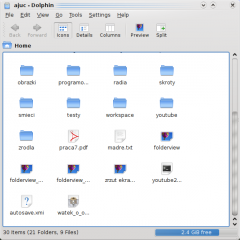
Когда мы открыли Dolphin из меню Kickoff он отобразил ваш начальный каталог - по умолчанию ваша это ваша Домашняя папка.
Просто щёлкните, чтобы открыть файл или папку. (Это может быть изменено на двойной клик в , по желанию. Некоторые дистрибутивы устанавливают двойной клик по умолчанию.) в KDE 4.5 это находится в
Чтобы выделить или отменить выделение файлов и папок переместите указатель мыши над значком и щелкните на знаки плюс и минус соответственно. Как тут:
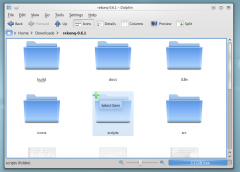
Когда вы щелкните на знак плюса, файл или папка будут добавлены выделенному. Выбор можно сделать также путем перетаскивания прямоугольника (иногда называемый "резинкой"), а также выбрать и отменить с помощью Ctrl + щелчок по одному и Shift + щелчок для последовательного диапазона.
Многие выделенные файлы выглядит следующим образом:

Создание новой папки: Вы можете создать новую папку в активном каталоге, используя или комбинацию F10.
Вкладки: Dolphin поддерживает просмотр с вкладками. Новую вкладку можно открыть, например из , Ctrl + T или нажатием средней кнопки мыши по значку папки и кнопками навигации.
Когда мы щёлкаем на любую папку, по умолчанию открывается Dolphin . Кроме того, он также может быть запущен из меню Kickoff.
Панель навигации
Dolphin объединяет в себе новую концепцию использования навигации более быстрым и более точным способом: Для достижения такого эффекта используется панель навигации в виде цепочки. Вместо отображения полного пути используется только навигация по пунктам, которые отображаются в виде кнопок. Щелкнув одну из этих кнопок, вы перейдете непосредственно в эту папку. Таким образом, вы можете получить доступ к родительскому каталогу с вложенной папке очень быстрым способом.
Между кнопками, которые представляют собой папки есть стрелка, которая также является кнопкой. Щелкнув на эту стрелку вы можете увидеть список всех подкаталогов на том же уровне, что и текущий, позволив вам быстро сменить каталог.
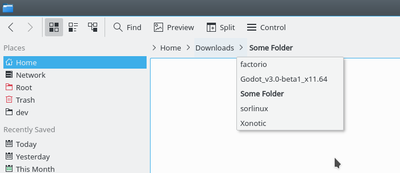
Существует также классическая навигационная панель, отображающая полный путь. Для использования этого стиля можно выбрать или вызвать сочетанием клавиш Ctrl + L. Щелкнув на свободное место рядом с последней отображенной папкой в иерархической стиле, который вы также можете сменить на классический стиль. Если классический стиль выбран, галочка отображается в конце панели навигации. Этот флажок является кнопкой, которая может быть использована чтобы сменить обратно на предыдущий стиль "цепочки". Конечно же, также можно использовать меню и сочетания клавиш.
Раздельный просмотр
Dolphin предлагает возможность разделить текущую папку так, что две папки отображаются рядом друг с другом, как знакомо из Midnight Commander. Это очень удобный вид для копирования или перемещения файлов из одной папки в другую.
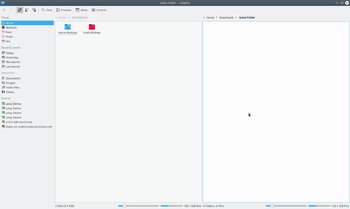
Вы можете разделить вид из (сочетание клавиш F3). Чтобы вернуться к просмотру только одной папки Вы можете использовать . Символ покажет вам, какой вид будет закрыт. В зависимости от активного в данный момент вида знак минуса будет показан в левой или правой части символа. Активный вид будет закрыт. Это важно знать, если вы хотите использовать сочетания клавиш. Существует также кнопка для разделения и закрытия вида, расположенная на панели инструментов. Эта кнопка отображается в виде минуса, что помогает легко узнать, какой вид будет закрыт.
Конечно, каждый вид имеет свою собственную панель навигации и с каждым из них можно использовать другой режим просмотра.
Режим просмотра
Dolphin поддерживает три различных режима просмотра: "Значки", "Таблица" и "Столбцы". Они могут быть изменены в меню или посредством клавиатурных сокращений Ctrl+1 (Значки), Ctrl+2 (Таблица) и Ctrl+3 (Столбцы). Существует также кнопка для каждого из режимов просмотра на панели инструментов и контекстное меню просмотра папок предлагает подменю , чтобы изменить режим просмотра.
Значки
Каждый файл или папка представляется ввиде значка в режиме "Значки". Вместо значка может быть отображена миниатюра файла. Это поведение можно активировать или деактивировать через меню или соответствующим элементом на панели инструментов. Присутствует ограничение размера миниатюр файлов. Это ограничение может быть настроено через параметр . Также пристутствует параметр для использования встроенных миниатюр в файлах. В KDE 4.5 миниатюры активируются (и указывается максимальный размер) при помощи
Файлы в текущей выбранной папке отсортированы по умолчанию в алфавитном порядке. Способ сортировки может быть изменен через меню . Доступны следующие критерии сортировки:
- Имя
- Размер
- Дата
- Права доступа
- Владелец
- Группа
- Тип
- Адрес ссылки
- Полный путь
Кроме того, последовательность сортировки может быть определена при помощи меню или .
Присутствует возможность отобразить дополнительные сведения под значками. Может быть активировано и деактивировано через меню .
Вы можете сгруппировать значки для достижения наилучшего обзора. Активируется через . Теперь значки сгруппированы, а группы делятся на горизонтальные строки, содержащие имя группы, как заголовок. Группировка связана с выбранным критериям поиска.
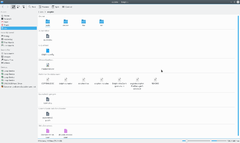
Details
In view mode "Details" additional information is displayed by default in contrast to view mode "Icons". All files are listed in a tabular. The context menu of the table header offers the possibility to add additional columns. The following columns are available:
- Size
- Date
- Permissions
- Owner
- Group
- Type
- Link Destination
- Path
Column "Name" is always displayed. By clicking on the header of one of the columns the table will be sorted by this column. By clicking on the same column header the sorting sequence is reversed.
Since KDE 4.1 it is possible to display the folders as a tree. In this mode a plus sign is shown next to the folder. By clicking on this sign the folder is expanded and all containing sub folders and files are also shown in the table but they are attenuated. By clicking the sign, which display a minus now, again the expansion is closed again. Of course the tree structure can be used for as many folders as wished. The tree view is disabled by default, but can be activated via with option .
Columns
View mode "Columns" is inspired by the file manager Finder of Mac OS X. Entering a sub folder does not replace the current folder view but the content of the sub folder is listed in an additional column next to the column of the parent folder. This can be used for several hierarchies, so that you can navigate in an easy and fast way in the file system.
Setting defaults for all folders
Under the menu item you can set any of these attributes to be the default for all folder views.
Panels
Dolphin contains several panels, which can be activated via menu . Each panel can be placed in the left or right docking area. To move a panel you have to click on the header and Drag&Drop the panel. The area where the panel will be placed on mouse released is highlighted. It is possible to stack panels on top of each other. In this case the panels are placed into tabs.
In the header of each panel there are two buttons. The button near to the caption undocks the panel. This makes the panel an independent window which "floats" above Dolphin. The window is still combined with Dolphin and cannot be displayed without Dolphin and cannot for example be minimized like normal windows. By clicking the button again the panel is docked again. The second button will close the panel.
Non Modal Dialogs
When Moving, Copying or Deleting files/directories the dialog disappears even when the operation has not yet completed. A progress bar then appears in the bottom right of the screen, this then disappears also, if you want see the progress you need to click a small (i) information icon in the system tray.
Places
Dolphin contains a new kind of bookmarks Places. These are displayed in a panel which can be activated via (keyboard shortcut F9). The default Places are identical to the one shown in the category System of the K-Menu Kickoff.
By clicking one of these places it will be opened in the current folder view. The context menu offers the possibility to edit the places or to remove them again. It is also possible to hide entries temporarily.
The context menu of a folder can be used to add this folder an another entry to the Places panel. Therefore there is a menu item . You can also Drag&Drop a folder to the Places panel.
The places panel also contains entries to connected removable devices like USB-keys or CDs. A small plug icon indicates if the device is mounted. The context menu offers the possibility to unmount the device.
The places are used as the basis in the breadcrumb navigation bar. Each address is shown in relation to the nearest parent folder which is one of the places.
Information
The information panel can be activated via (keyboard shortcut F11). This panel displays a preview or an icon of the currently selected file/folder or of the file/folder below the mouse cursor. Some additional information like change date or size to the file/folder is displayed as well.
The information panel offers the possibility to rate files, add a comment or tag a file. This is one of the interfaces to the semantic Desktop Nepomuk which provides the advantages of the semantic web for the desktop. Starting from KDE 4.2 it is possible to search for the semantic links given by the tags.
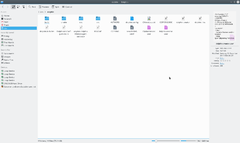
Folders
A panel providing a tree structure for the file system can be displayed via (keyboard shortcut F7). The tree structure offers the possibility by clicking the + and - signs to expand/collapse sub folders. By clicking on one of the folders the content will be displayed in the current view.
Terminal
The terminal emulator Konsole can be displayed directly in Dolphin via (keyboard shortcut F4). This makes it possible to use shell commands directly in Dolphin. The terminal is opened in the folder which is displayed in the current view. Shift + F4 opens Konsole in new window.
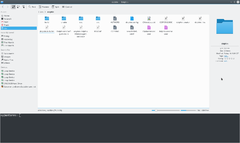
External links
Road to KDE 4: Dolphin and Konqueror
Ars Technica: A First Look at Dolphin
Youtube - KDE 4 rev 680445 - Dolphin
Introducing KDE 4 Blog - Dolphin
Bookmarks and Places
In KDE3 you could create bookmarks in Konqueror, but they were not available to any other application. KDE SC 4.x opens up a great deal more flexibility - but that inevitably means more complication. In fact KDE SC 4 has three classes of Bookmarks, which need to be differentiated. They reside in different files, and have different functions.
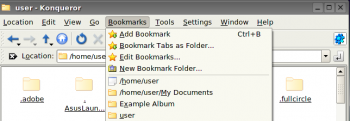
Three kinds of bookmark
First, there is the set of bookmarks available only to Konqueror - web bookmarks. These are stored in ~/.kde/share/apps/konqueror/bookmarks.xml. Then there is a set which Dolphin calls Places. This set is available to all applications as well as the Dolphin file manager. Every time you use you will see this set. The third set of bookmarks are Application Bookmarks. These share one file, regardless of the application that set them, and are available to all applications, unless you restrain them to a specific application. More of that later.
Enable bookmarks
In most distros Bookmarks are not enabled by default. In order to use bookmarks we first have to enable them. Open a in most KDE applications and you will see, at the right-hand edge of the icon panel, a spanner or wrench. From the drop-down list, choose .
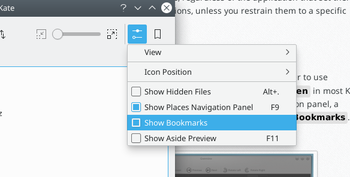
There is a default set of Places -
- Home
- Network
- Root
- Trash
but you can add other places. In Dolphin, right-click on a folder and select , or just drag a folder onto Places.
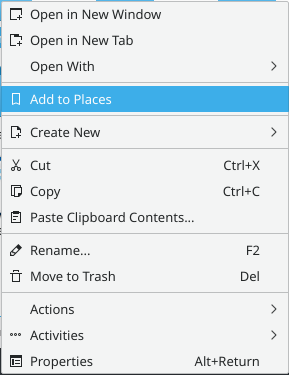
By default this "Place" will be visible in all applications. If you want to keep it constrained to Dolphin, you need to right-click on the new name in the Places list, where you will find the option to Edit it. There is a check-box for .
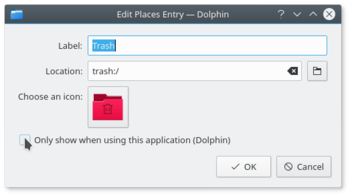
You can see the result of that command if you read ~/.kde4/share/apps/kfileplaces/bookmarks.xml.
In some applications too there is an option in the File menu to add a folder to Places. At this stage, however, applications vary in which features are available. The important thing to remember is that the default is for Places items to be available to all applications in the dialogue.
Bookmarks in applications
This is the second class of bookmarks. Remember opening and using the spanner/wrench? Next to it is a yellow star. This is the bookmark management menu.
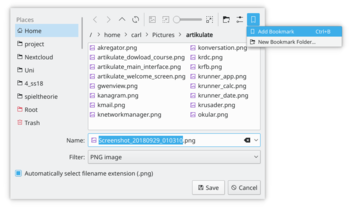
Here you can define bookmarks that will be visible in the same menu on any application. They are stored in one file, ~/.kde4/share/apps/kfile/bookmarks.xml, which is used by all applications having that menu.
Constraining to one application
Some applications allow you to edit items in the Places menu. For instance, if in Gwenview you right click on a folder in Places you can set an option to .
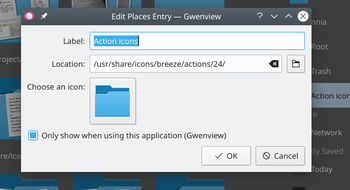
If you need to constrain to an application that does not yet allow you to do that, the only way left is to edit the file ~/.kde/share/apps/kfile/bookmarks.xml. Immediately before the </metadata> tag you will need to add the line
<OnlyInApp>appname</OnlyInApp>
Archive Management in Dolphin
Managing archives now becomes simple. In any directory in Dolphin, highlight the files that you want to compress, and right-click. Here, using the Compress option, you can elect to create a RAR archive, a Gzipped tar archive, or define another compression mode that you have already set up.
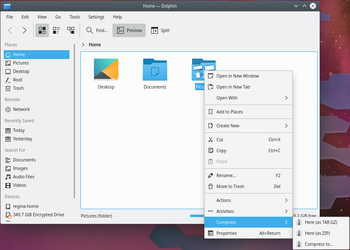
Similarly, if you right-click on an existing archived file you get a range of actions added to the right-click menu. You can extract the archive to the current folder, to an autodetected subfolder or to another place of your choosing.
Should you wish to add files to an existing archive, you can choose .
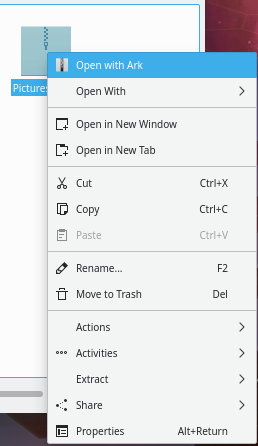
More Cool Actions
Change a File Association on-the-fly
Have you ever wanted to open a file, only to find that it is associated with an application that is not of your choice? You can, of course, alter this in . But Dolphin and Konqueror offer you a quick and cool method for changing a single association.
Right-click on the file and select . The first line there is descriptive, something like:
Type: XML document
At the same level, on the right, there is a spanner (wrench). Click on that and you can add or change an association.
Similarly, by working on a folder, you can change the default file manager to/from Konqueror, if you choose, or add another image browser to the possible associations.
The sub-menu opens up a whole lot more cool things to do from Dolphin. Some possibilities only appear when applicable to the file you have selected. Some of the options are
- Convert an image file to a different format
- Preview the file
- Download a remote file with KGet
- Sign and/or encrypt the file, according to the encryption software installed
Encode and copy audio CD tracks
- Insert an audio CD
- Navigate to this CD in Dolphin: it must appear as "Volume" in your Dolphin 'Places' or you can reach it by typing audiocd:/ in the address bar.
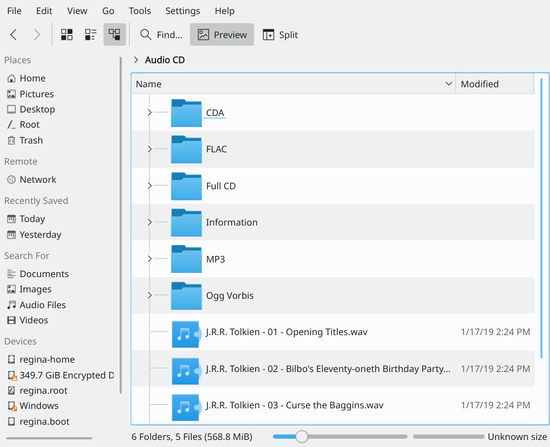
You now notice that Dolphin is proposing a WAV file for each track, plus:
- a CDA folder containing indexing information in the usual CDA format.
- a Whole CD folder, containing one file for each format (.cda, .flac, .mp3, .ogg, .wav) holding all the tracks
- a FLAC folder, containing the tracks encoded into FLAC format (lossless information format)
- an Information folder containing the CDDB informations
- an MP3 folder, containing all the tracks in MP3 format
- a Ogg Vorbis folder, containing the tracks encoded in OGG format
You then just have to copy the folder of your choice, in your preferred format to obtain the relative encoded version of your CD!
Have your recent files as home
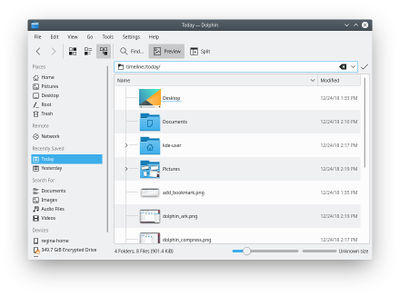
Dolphin has access to a large number of file transfer protocols (KIO Slaves). One of those is provided by the KDE semantic search system (Nepomuk). Nepomuk offers a transfer protocol named history. You can navigate to it by entering timeline:/ in the location bar.
One particularly neat thing there is the ability to have the Today folder from the timeline:/ protocol in the Places sidebar (you can just drag it there!). You can then change the name and icon (do a right click on the new Today entry and choose ).
It could be very useful to have this view of recently used files immediately when you start Dolphin. Unfortunately, as of Dolphin 2.1 (part of KDE SC 4.9) this is not possible without editing the Dolphin configuration file. See this blog for more details on that.
To edit the configuration file, first close all Dolphin windows. Dolphin will save its configuration upon closing, overwriting any changes you might make!
Then use KRunner (Alt + F2) to edit ~/.kde4/share/config/dolphinrc (or ~/.kde/share/config/dolphinrc, depending on your distribution) with KWrite as follows: kwrite ~/.kde4/share/config/dolphinrc. You can of course use any other editor as well, like Kate. In the configuration file, locate the [General] section to edit the HomeUrl into: HomeUrl=timeline:/today and save the file. You should now have the today view as default and have the files you're most often looking for at your fingertips!



